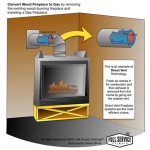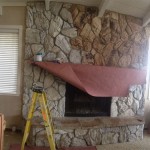Stone Veneer Panels: An Elegant and Practical Solution for Fireplace Facades
Fireplaces serve as both functional heating elements and focal points within residential and commercial spaces. The aesthetics of a fireplace significantly contribute to the overall ambiance of a room, making the choice of facing material crucial. Stone veneer panels have emerged as a popular and versatile option for fireplace facades, offering a blend of visual appeal, ease of installation, and cost-effectiveness compared to traditional solid stone construction.
Stone veneer, in its essence, is a manufactured or natural stone product meticulously crafted to resemble the appearance of full-thickness stone. These veneers are significantly lighter and thinner, allowing for simpler installation on a variety of surfaces. When applied to fireplaces, stone veneer panels recreate the timeless elegance of natural stone without the structural demands and expense associated with solid stone. This article delves into the properties, advantages, and considerations surrounding the use of stone veneer panels for fireplace applications.
Aesthetic Versatility and Design Flexibility
One of the most compelling attributes of stone veneer panels lies in their aesthetic versatility. Manufacturers offer a wide array of styles, colors, textures, and patterns meticulously designed to mimic various types of natural stone. This allows property owners to achieve the desired look, ranging from rustic fieldstone to contemporary stacked stone, without being limited by the availability or cost of specific natural stone materials. The diverse selection enables seamless integration with various architectural styles and interior design themes.
The inherent design flexibility of stone veneer panels extends beyond mere aesthetics. The panels can be easily cut and shaped to accommodate different fireplace dimensions and architectural features. This eliminates the need for extensive on-site modifications, which can be time-consuming and costly with solid stone. The modular nature of the panels also facilitates intricate designs and patterns, enabling homeowners to create unique and personalized fireplace facades. The panels are available in a selection of sizes, which helps minimize waste and optimize their layout.
Furthermore, stone veneer panels often come in pre-assembled units, simplifying the installation process and ensuring consistent appearance. This is particularly beneficial for larger fireplace surrounds where maintaining uniformity in texture and color can be challenging with individual stone pieces. The pre-assembled nature reduces the potential for human error during the installation phase, contributing to a more polished and professional finished product.
The application of stone veneer is not limited to the immediate fireplace surround. It can extend to create accent walls above or around the fireplace, effectively unifying the hearth with the overall room design. This holistic approach to design maximizes the visual impact of the stone veneer and creates a cohesive aesthetic experience.
Enhanced Installation Efficiency and Reduced Costs
Traditional stone masonry is a labor-intensive process requiring skilled artisans and specialized tools. The installation of solid stone fireplaces can be time-consuming and costly, involving extensive site preparation, structural reinforcement, and meticulous placement of individual stones. Stone veneer panels, on the other hand, offer a significantly more efficient and cost-effective alternative.
The lightweight nature of stone veneer panels allows for installation on a wider range of surfaces without the need for substantial structural support. This reduces the overall construction costs and simplifies the renovation process. The panels can be adhered to existing brick, concrete, or wood framing using readily available adhesives and fasteners, minimizing the need for specialized equipment. The relative ease of installation makes it a feasible option for both professional contractors and experienced do-it-yourselfers.
The reduced weight also contributes to lower transportation costs. Shipping and handling solid stone can be expensive due to its bulk and weight. Stone veneer panels are lighter and more compact, resulting in significant savings on transportation. This makes stone veneer a more accessible and budget-friendly option, especially for projects located in remote areas where transportation costs can be prohibitive.
The panel system streamlines the installation process. Instead of fitting individual stones, installers can quickly apply larger sections of veneer, covering a greater surface area in less time. This accelerated installation schedule translates into reduced labor costs and a faster project completion time. This efficient installation is particularly advantageous for large-scale projects, where minimizing downtime is critical.
While stone veneer is less expensive than natural stone, the cost can vary greatly depending on the material used and the complexity of the job. Manufactured stone veneer can be more affordable than natural stone veneer. Intricate designs and patterns will also increase the cost of the project. It is important to obtain estimates from different installers and understand the overall cost of the project before making a decision.
Durability, Safety, and Maintenance Considerations
While stone veneer panels offer aesthetic and installation advantages, their durability, safety, and maintenance requirements are crucial considerations for fireplace applications. The materials used in the construction of stone veneer panels play a significant role in their long-term performance and resistance to heat, moisture, and wear.
Manufactured stone veneer panels are typically made from a mixture of cement, aggregates, and pigments, carefully engineered to replicate the look and feel of natural stone. These panels are designed to be fire-resistant and can withstand the high temperatures associated with fireplace use. However, it is essential to choose products that meet or exceed relevant fire safety standards and building codes. Proper installation, including the use of non-combustible backer boards and appropriate clearances from the firebox, is crucial to ensure the safety of the installation.
Natural stone veneer panels, on the other hand, are sourced directly from natural stone quarries and cut into thin veneers. These panels offer inherent durability and resistance to heat. However, the specific properties of natural stone can vary depending on the type of stone. Some types of natural stone are more porous than others, making them susceptible to staining and moisture damage. Sealing the surface of natural stone veneer panels can help protect them from these elements and prolong their lifespan.
Regardless of the type of stone veneer used, regular maintenance is essential to preserve its appearance and integrity. Dusting the surface of the panels with a soft cloth or brush can help remove loose dirt and debris. For more stubborn stains, a mild detergent and water solution can be used. It is important to avoid using abrasive cleaners or solvents, as these can damage the surface of the veneer.
The longevity of stone veneer panels is heavily influenced by the quality of installation. Proper adherence to the manufacturer's instructions and the use of appropriate adhesives and fasteners are crucial for preventing the panels from detaching or cracking over time. Regular inspections and prompt repairs of any damage can help extend the lifespan of the installation.
Before making a final decision, consulting with a qualified contractor or building professional is highly recommended. They can provide valuable insights into the suitability of stone veneer panels for a specific fireplace application, taking into account factors such as the existing structure, building codes, and local climate conditions. This expert advice ensures a safe, durable, and aesthetically pleasing fireplace facade.

Natural Stacked Stone Veneer Fireplace Ideas

Stone Cladding On Fireplaces Need To Know Nustone

How To Install Faux Stone Veneer Lowe S

Stone Fireplace Design And Remodel

The Benefits Of Thin Stone Veneer For Your Fireplace

Real Stone Veneer River Rounds Stonewood S

Faux Stone Panels Veneer Selex

Fireplace Stone Cladding Norstone Experts

Staxstone Fireplaces Gallery Real Stone Veneer

Thin Stone Veneers Make A Fireplace Update Easy Swenson Granite 100 Natural Stones
Related Posts








